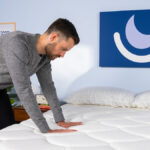High blood pressure and obstructive sleep apnea (OSA) often occur together. Experts estimate that about half the people with OSA also have high blood pressure, also called hypertension.
Obstructive sleep apnea is a sleep disorder in which a person’s breathing is interrupted frequently during sleep when the airway narrows or closes. If OSA is not treated, it can lead to increased risk of many health problems, including heart disease, hypertension, depression, anxiety, and accidents due to daytime drowsiness.
Can Sleep Apnea Cause High Blood Pressure?
Having obstructive sleep apnea can significantly raise your chance of developing high blood pressure. People with OSA are also more likely to develop hypertension that does not respond well to drugs, called treatment-resistant hypertension.
OSA can contribute to high blood pressure through several processes:
- Repeating pauses in breathing during sleep can lower the level of oxygen in the blood and increase the level of carbon dioxide. These changes stimulate a stress response, sometimes called “fight or flight,” that prepares your body to act and increases heart rate and blood pressure
- Changes in blood oxygen and carbon dioxide levels can also elevate certain hormones in response to stress, including adrenalin. Stress hormones also raise blood pressure.
- Regularly experiencing insufficient sleep increases a person’s risk of a range of health conditions, including high blood pressure and cardiovascular problems.
All of these changes occur during sleep, a time when a person’s blood pressure is typically reduced. OSA can interfere with this normal nighttime dip in blood pressure, keeping average blood pressure high and adding to the risk of heart problems and organ damage.
The Relationship of Sleep Apnea and Blood Pressure
Experts believe that about 50% of people with OSA also have high blood pressure. While obstructive sleep apnea itself can contribute to high blood pressure, sometimes OSA and high blood pressure both result from another cause. In fact, a number of risk factors for OSA are also risk factors for high blood pressure.
Risk factors for both OSA and high blood pressure include older age, obesity, alcohol use, and smoking.
Will Treating Sleep Apnea Lower Blood Pressure?
Treatments for obstructive sleep apnea can decrease the risk of high blood pressure.
OSA is often treated with positive airway pressure, using devices such as continuous positive airway pressure (CPAP) or automatic positive airway pressure (APAP). Treatment with CPAP can reduce both blood pressure and the risk of heart attack and stroke.
Other treatments for sleep apnea may also help lower blood pressure. People who are treated for OSA using an oral appliance also have a reduction in blood pressure. Hypoglossal nerve stimulation therapy for OSA has also been shown to lower blood pressure.
When to Talk to Your Doctor
Because high blood pressure can easily go undetected, it is important to have your blood pressure measured even if you don’t have symptoms or concerns. Health care providers will often measure your blood pressure during office visits.
It is also possible to check your blood pressure at drugstores, health fairs, and other settings. You can also buy a blood pressure monitor without a prescription and check your blood pressure at home. If high blood pressure is detected, talk to your doctor and ask about treatment options.
Obstructive sleep apnea usually causes symptoms, although they may be noticed first by friends, family, and those who sleep near you. If you suspect you have sleep apnea, it is important to bring up this concern with your doctor who may recommend taking a sleep test, since treatment can improve symptoms and benefit your overall health.
Symptoms that may indicate the presence of OSA include:
- Loud snoring
- Periods when breathing stops during sleep
- Snorting and gasping while asleep
- Daytime sleepiness
- Morning headaches
- Irritability during the day
References
Ask the Sleep Doctor
Have questions about sleep? Submit them here! We use your questions to help us decide topics for articles, videos, and newsletters. We try to answer as many questions as possible. You can also send us an email. Please note, we cannot provide specific medical advice, and always recommend you contact your doctor for any medical matters.


